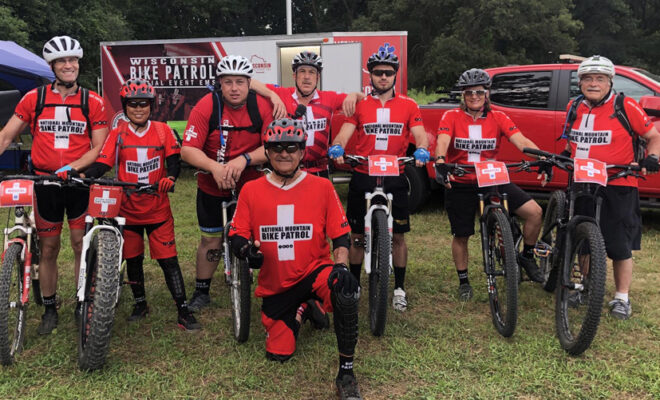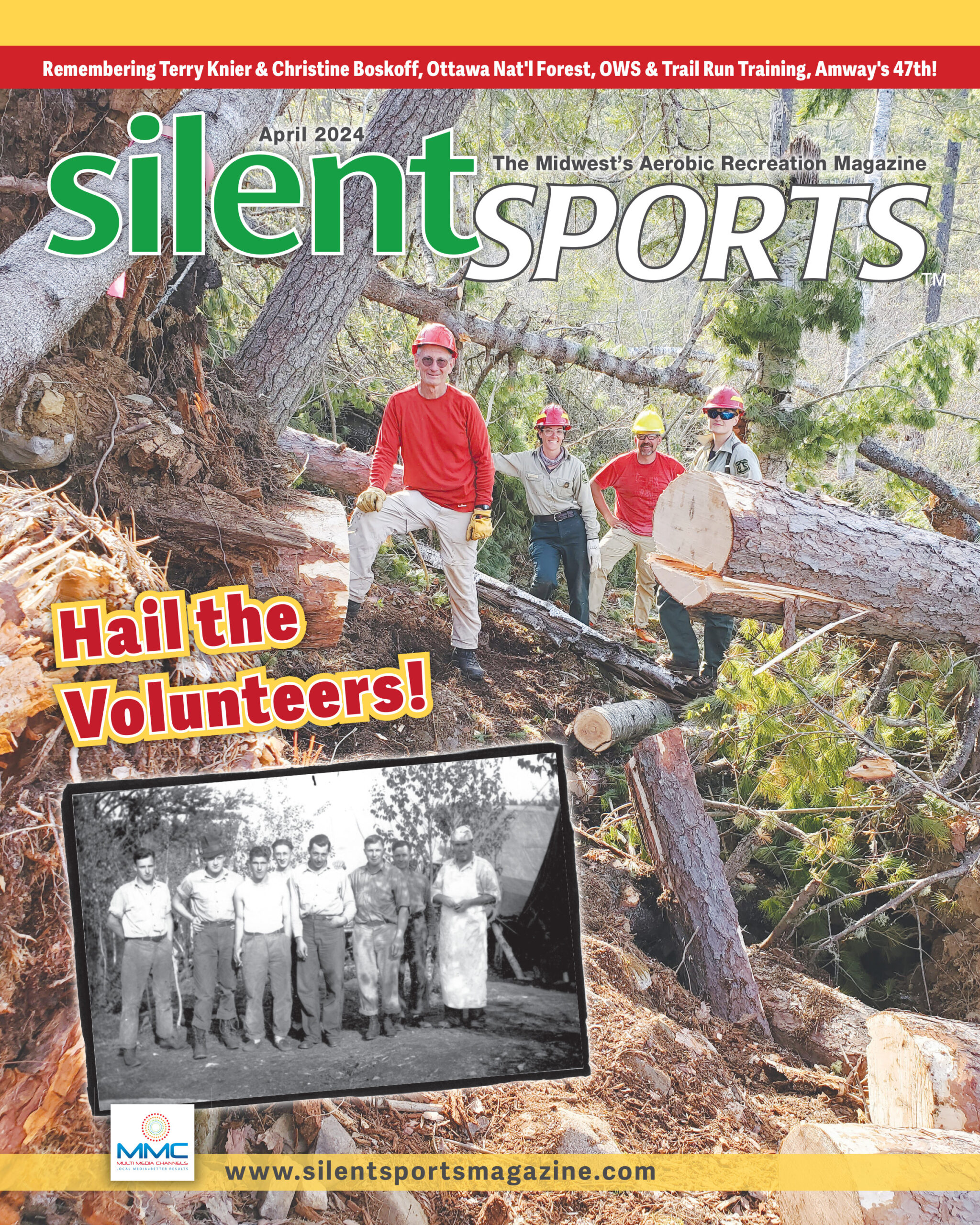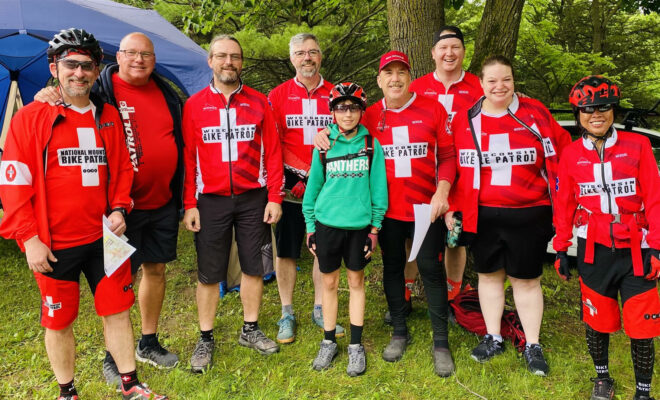Highly Trained, Dedicated, and All-Volunteer: How the Wisconsin Bike Patrol Works to Serve You

George Pastorino
Editor’s Note: George Pastorino is President of the Elmhurst Bike Club and a Certified Mountain Bike Skills Instructor, as well as a volunteer Bike Medic, working many events with the Wisconsin Bike Patrol. He also volunteers with Project Mobility to provide specially adapted bicycles to physically challenged children and wounded warriors. A 20-year resident of Justice, IL, he has served in local government since 2008 as a Village of Justice Trustee and as Chairman of the Justice Police Commission, and has been certified by the Commissioners Training Institute. He retired in 2014 after spending 38 years as a surgical instrument repair specialist and master instructor for Prezio Health.

Patrollers left to right: Danny Bobrow, Pussanee Pastorino, Jeff Davis, Dave Mangan, Nick Duhm, Molly Duhm, James Doc Marx, and George Pastorino. Click on images to enlarge.
If you have been involved in bike events of any sort in Wisconsin, and even some longer running events, you probably have seen the white and red Medical tents and trailers of the Wisconsin Bike Patrol (WBP). You may have also seen Patrol members on bikes, with first aid kits and medical license plates.
The WBP is a 501(c)3 nonprofit with the mission of providing onsite medical support to mountain bike races, marathons, multi-day organized road rides, and special events throughout Wisconsin. The WBP also provides medical coverage to the Wisconsin High School Cycling League, which is part of the National Interscholastic Cycling Association and several large events in Illinois including the Palos Meltdown.
WBP personnel include a mix of the following Health Care Professionals: Paramedics, EMTs, Flight Nurses, Physicians, and Surgical Trauma Nurses. The WBP has a vast array of formidable first aid equipment, including: automated external defibrillators, bleeding control kits, slings, structural aluminum malleable splints, airway intubation kits, portable emergency oxygen unit with cylinder, mask and regulator, epinephrine auto-injectors, ice packs, cravat triangle bandages, body boards for patient transfer, survival rescue blankets, stethoscopes, blood pressure monitors, and hundreds of other pieces of first aid supplies. With all Patrollers carrying radios, the WBP handles communication using a 30-foot radio tower that gives these radios a strong signal over many miles of trails with clear transmissions throughout the venue. For events, the WBP deploys its medical trailer, treatment tent, pickup truck, wind feather flags, radio tower, bike racks, and Rescue 1 which is a 6-wheel drive evacuation vehicle. Rescue 1, filled with medical equipment and a paramedic seat, can climb steep hills and has a winch on the back and a 1up rack on the front.

Director Mangan teaching Rescue 1 operation to a WBP Team. All photos courtesy of the Wisconsin Bike Patrol.
Around for decades, the WBP has as its State Director David Mangan, who is the driving force behind the organization’s growth and daily excellence shown by his well-qualified, active Patrollers, now numbering over 45. All, including Mangan, are volunteers. The WBP can operate only because of donations received from race directors and the community at large. Director Mangan and fellow Board Members, James “Doc” Marx, Mike Crabb, and Jeffery Galvin, run yearly training sessions for Patrollers. All Patrollers must have a minimum of an Outdoor Emergency Care or Wilderness First Responder Certification, or equivalent training and experience. In addition, they must have solid mountain bike handling skills and a friendly demeanor, along with a desire to help people, as well as the ability to effectively communicate.
Patrollers must wear the WBP uniform: jerseys, shorts, jackets, socks, and bike license plates emblazed with the white medical cross on a red background, which is the universal symbol for first aid and medical assistance. This makes them easy to identify and visible to racers and Patrollers riding the entire race course.
All Patrollers must work within their medical qualifications, wear helmets, and ride within their abilities. This is why you may see Patrollers walking technical sections even if within their abilities to ride them; they are there to provide medical assistance, not to need it. With Safety First being rule one, Patrollers are committed to assisting anyone in need of medical attention or with mechanical difficulties, so they must have knowledge of emergency bike repair. They also fix or report any unsafe conditions, hazards, or obstacles, and always ask if they can help with all situations.
At a typical large event, 600-plus racers may participate, with double the spectators. The WBP treats medical issues for both. Personnel arrive 90 minutes before start time to find a suitable site for their staging area, set up the medical tent and trailer, offload Rescue 1, raise the radio antenna, and prepare the operation to receive injured or sick racers or spectators. Director Mangan will meet with the race director, course officials, and other race personnel to get a layout of the course, and identify potential trouble spots or technical sections where racer mishaps could occur. He also notifies the local Fire/Rescue Team of the operation so they can coordinate what an expected response time would be and the best way for the Patrol to initiate that.
Depending on the size of the event, Mangan will notify the closest hospital and the WBP’s role in managing an on-the-ground medical response team. He will provide both race personnel and local Fire/Rescue/Paramedic Teams with an Emergency Action Plan (EAP). This vital plan determines evacuation procedures and emergency escape route assignments, implements a clear chain of command and designation of the person authorized to order an evacuation, and puts in place procedures for all involved to follow in case of a serious patient medical evacuation or an entire evacuation of an event due to unforeseen circumstances such as a tornado, dangerous lightning, or forest fire. An EAP will also spell out how each event or injury is to be documented by Patrol personnel.
Mangan then has a pre-race meeting with his team of Patrollers, from 15 to 25 since the all-volunteer makeup of the team at each event will vary. He assigns patrollers to various hot spots on the course where they will stay while assigning others to ride the course as the racers do, and respond to any accidents where they happen. Other Patrollers are assigned to work the medical tent or drive Rescue 1 as needed. Mangan manages the entire operation and also works the medical tent, rides the course, and drives Rescue 1 as needed.
In an average race, the WPB treats dozens of racers and spectators in the medical tent and on the trails, from broken wrists and shoulders, facial lacerations, heat exhaustion, dehydration, deep knee and elbow wounds, cramps, dislocated fingers, and cases of heat stroke. Patrollers triage patients to determine the priority of patients’ treatments by the severity of their conditions or likelihood of recovery with and without treatment. Injured or sick racers are evaluated and placed in one of three categories: Immediate, those requiring immediate life-saving treatment; Urgent, those requiring significant intervention as soon as possible; or Delayed, those requiring medical intervention but not with any urgency.
Racers needing medical treatment beyond the WBP’s scope, such as x-rays, other imaging, and/or advanced tests or surgery, will be evacuated via the local Ambulance/Fire/Rescue Team in accordance the previously provided EAP. A myriad of medical issues will keep the Patrollers busy, usually with several racers evacuated by ambulances to local hospitals. The Patrol does its best not to impede racers, but this sometimes happens. Fortunately, most racers understand, knowing the Patrollers are there for their safety.
Many race directors no longer feel it’s safe or prudent to run a large event without the presence of the WBP. Racers often comment to Patrollers that they are put at ease when they arrive and see our extensive medical operation. Patroller Pussanee Pastorino is entering her fifth year as part of the Team. Even though she has advanced training as a surgical trauma nurse, she is consistently impressed by the quality of medical care the WBP provides and the professional manner in which this care is provided. All Patrollers are proud and grateful to be part of such a respected and well-run organization which allows large events to happen in a safe environment. Most of all, the WBP’s volunteered services are there for you.




